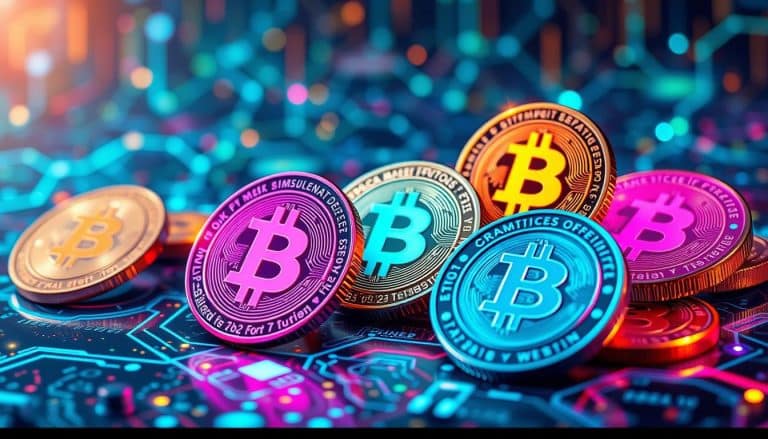Xrp Nft Trends
Non-fungible tokens (NFTs) are digital assets that are unique and not interchangeable. These tokens, which have become increasingly popular in recent years, can be used to represent ownership of digital assets such as art, music, clothing and even real estate. XRP NFTs are a relatively new type of token based on the XRP blockchain technology developed by Ripple Labs. This article will discuss recent trends in the use of XRP NFTs, potential uses for these tokens and strategies for investing in them. It will also cover important regulatory requirements and provide examples of popular XRP NFTs currently available on the market.
Overview of NFTs
The emergence of non-fungible tokens (NFTs) has created a new digital asset class that is revolutionizing the way digital ownership is being exchanged and tracked. NFT marketplaces are now emerging, allowing users to trade tokenized assets with the security of blockchain technology. These platforms provide an efficient way to access, own, transfer, and track digital assets in a secure manner. NFTs have become increasingly popular in recent years due to their ability to represent unique digital entities such as artworks, gaming items, and collectibles. This has resulted in a surge of interest from investors who are eager to capitalize on this new asset class. As the NFT market continues to mature, it will be interesting to see what other use cases emerge for these tokens and how they will shape the future of digital ownership. The next section examines XRP’s foray into the NFT space with an introduction into its offering.
XRP NFTs: An Introduction
Cryptocurrencies have enabled the development of a new class of digital asset, often referred to as non-fungible tokens (NFTs). For example, an individual could create a limited edition artwork which is tokenized on the blockchain. XRP NFTs are becoming increasingly popular in the crypto community as they offer a unique way to represent and transfer value. They can be used for many applications such as gaming items, collectables or digital art. XRP NFTs provide a secure and efficient way to buy, trade and store assets on the distributed ledger technology (DLT) platform:
- The ownership of an XRP NFT is secured by its unique cryptographic signature
- It can be transferred almost instantly with low transaction fees
- It offers transparency in transactions due to its public ledger structure
- Its immutable nature ensures that it cannot be counterfeited or modified
XRP NFTs offer some advantages over other cryptocurrencies, making them ideal for various use cases within the crypto world. By leveraging these features, users can easily manage their digital assets while ensuring their security remains uncompromised. With this in mind, let’s now look at recent XRP NFT trends to see how they are impacting the market place today.
Recent XRP NFT Trends
Recent developments in the digital asset market have seen a surge in interest surrounding non-fungible tokens (NFTs). This is particularly true for XRP-based NFTs, which leverage the blockchain technology of the third largest cryptocurrency. As more and more people become aware of cryptocurrency and its potential, there is heightened interest in finding novel use cases for it. One of these emerging trends is digital scarcity through XRP NFTs. This trend takes advantage of the fact that XRP can be used to create legally binding digital contracts while also providing a secure medium to store them on the blockchain. Additionally, XRP’s fast transaction times and low fees make it a desirable choice for those looking to quickly transfer funds or purchase rare digital assets. As such, users are increasingly turning to XRP-based NFTs as a way to capitalize on cryptocurrency adoption and digital scarcity trends.
Potential Uses of XRP NFTs
XRP NFTs have the potential to be used as crypto collectibles, digital art, and for gaming. As a form of digital asset, XRP NFTs can be used in a variety of ways to add value to an individual’s collection or portfolio. Additionally, they open up possibilities for digital artists who wish to create unique works of art that are permanently stored on the blockchain. Finally, XRP NFTs can also be utilized within gaming platforms and applications where players can use them as rewards or even as currency to purchase items.
Crypto Collectibles
Recently, crypto collectibles have emerged as an increasingly popular form of digital asset that can be bought and sold like traditional cryptocurrencies such as XRP, yet offer unique ownership rights not available in other forms of cryptocurrency. These collectibles are generally auctioned off through decentralized exchanges, with the highest bidder winning the item. This is a stark contrast to traditional currency transactions where bids are typically placed through centralized marketplaces. Additionally, these collectible items may also come with exclusive benefits or features not available in other forms of cryptocurrency. For example, some of these assets may confer voting privileges or access to certain services on their respective blockchain platforms. As such, they provide investors with more control over their investments than standard coin offerings do. By leveraging the same underlying technology as XRP and other cryptocurrencies but offering unique features and ownership rights, crypto collectibles have become extremely attractive investments for traders looking to diversify their portfolios beyond standard coins and tokens. Furthermore, this new class of digital assets has opened up opportunities for those interested in monetizing rare digital art or creating limited edition goods that can only be accessed by holders of certain crypto collectibles.
Digital Art
The recent surge in NFTs has brought attention to digital art, and the implications of its use within the blockchain space. The idea of using a decentralized ledger to display artwork is not only appealing due to its financial potential, but also because it allows artists to create and share their work without relying on centralized platforms such as social media. This provides an opportunity for artists to gain recognition for their work outside of traditional galleries and other art institutions. However, there are ethical considerations when it comes to digital art that must be taken into account in order for these projects to be successful.
Digital art ethics can include questions such as how much control does the artist have over their artwork once it is listed on a decentralized gallery? Can they revoke access or ownership from buyers if necessary? Additionally, creators should consider whether or not they want their artwork featured exclusively on a particular platform or distributed across multiple networks. These are just some of many ethical considerations when it comes to creating and selling digital art on the blockchain. Furthermore, decentralized galleries need to ensure that buyers know what they are buying and understand the implications associated with cryptocurrency-based transactions before making any purchases. As users become more comfortable working with cryptocurrencies, these issues will become less prominent; however, they remain important topics as we continue exploring this newly emerging sector of the NFT market. With these ethical concerns in mind, we can now turn our attention towards exploring how gaming is being affected by the rise in NFTs.
Gaming
With the advent of blockchain technology, gaming has become increasingly intertwined with the emerging NFT market. The novelty of digital ownership and trading platforms have created a unique way for gamers to earn money while playing their favorite games. As a result, there is now an enormous potential for game developers and publishers to monetize their products using non-fungible tokens (NFTs). This presents a lucrative opportunity as more people are able to trade game assets in exchange for real-world value. It also gives users the ability to have permanent ownership over their virtual goods, creating incentives for them to invest in these assets. Furthermore, NFTs can be used as rewards or prizes within various games, making them even more attractive to gamers.
The rise in popularity of NFTs within gaming has led to new trends that are quickly becoming commonplace in the industry. With more players getting involved in the NFT market, it is likely that we will see further developments such as innovative trading mechanisms and platforms that facilitate secure transactions between users. By leveraging the advantages of NFTs, game developers can create entirely new experiences by offering digital collectibles or other forms of virtual rewards that add additional value to certain game titles. In conclusion, it appears that the combination of blockchain technology with gaming is here to stay and should only continue growing in popularity going forward. This opens up many possibilities for both gamers and developers alike when it comes to earning money through digital assets associated with video games.
Security Token Offerings
Security Token Offerings (STOs) offer advantages over other cryptocurrency investments due to their increased levels of security and regulation. STOs are attractive because they provide investors with the security of traditional stocks but with the added benefits of blockchain technology, such as decentralization and immutability. However, there is potential for risk in these offerings, from issues like overcrowding or regulatory uncertainty. Therefore, it is important to consider both the advantages and risks associated with STOs before making an investment.
Security Token Advantages
Exploring the advantages of security tokens provides insight into how xrp nft trends can be utilized. Security Tokens are digital assets that are built on blockchain technology and can represent ownership in a variety of items such as real estate, artwork, stocks, derivatives, and other assets. Smart Contracts allow for an automated process that enable transaction of these digital tokens to securely occur. The tokenization of traditional assets offers several benefits:
- Increased Liquidity: Security tokens provide increased liquidity by allowing more people from around the world to purchase ownership stakes in traditional assets without geographical limitations or restrictions from centralized brokerages and exchanges.
- Accessibility & Fractional Ownership: By transforming physical assets into digital form, asset owners can now offer fractionalized ownership through security tokens, allowing more people access to investments previously available only to accredited investors with large capital reserves.
- Cost Savings: The use of smart contracts eliminates manual processes associated with traditional transactions resulting in cost savings for both buyers and sellers compared to traditional methods such as stock exchanges or brokers.
These advantages demonstrate how security tokens provide better access to global markets and increased liquidity while reducing costs for both buyers and sellers; thus presenting potential opportunities for xrp nft trends moving forward into the future. Potentially strong returns could be realized if investors understand the risk-reward tradeoff associated with these investments before proceeding further with their decisions related to this asset class.
Potential Risks
Investing in security tokens can bring potential rewards, but it is important to be aware of the associated risks. One of the main risks for investors is the privacy concerns that come with XRP NFTs. Byte-level privacy protections mean that they have a certain level of anonymity, which can make tracking and tracing transactions more difficult. Furthermore, there may be liquidity issues related to XRP NFTs since the market is still relatively new and not as liquid as other cryptocurrencies. As such, investors should assess their own risk tolerance when considering investing in XRP NFTs to ensure that they are comfortable with any associated risks. Overall, it is essential for investors to understand all potential risks before investing in an asset like this to avoid any unexpected losses or surprises. With that said, regulatory requirements must also be taken into consideration when looking at XRP NFT investments.
Regulatory Requirements
Despite the surge in popularity of XRP NFTs, regulatory requirements remain a necessary consideration to ensure compliance. Tokenization and Open Finance are two important aspects of this process which must be met in order to meet international regulations for digital assets. As with any other form of investment or asset, XRP NFTs must be subject to official registration and approval from governing bodies. The creation of such tokens also requires proper security measures in place to protect the interests and data of investors. Furthermore, these tokens should have clear definitions around ownership rights and responsibilities that can be enforced by law if needed in case of disputes or fraud. In addition to registration and security requirements, there must also be provisions for taxation, monitoring, dispute resolution and reporting as part of the legal framework surrounding the use of XRP NFTs. With this in mind, it is essential for those who wish to invest in XRP NFTs to understand all applicable laws before engaging in any transactions involving them. Transitioning into potential impact on these new technologies, it is evident that there will be drastic changes when it comes to how people interact with digital assets moving forward.
Potential Impact of XRP NFTs
The emergence of XRP Non-Fungible Tokens has the potential to revolutionize digital asset exchanges and create new opportunities for investment. NFTs are expected to bring a number of benefits to the DeFi marketplaces, including increased liquidity for digital assets, greater transparency in value exchange, and improved security from decentralization. With these features, XRP NFTs could potentially revolutionize the way people invest in digital assets by creating more efficient and secure trading platforms that are not subject to centralized control. As such, XRP NFTs may have a profound impact on financial markets by allowing investors to participate in an increasingly decentralized financial system.
The introduction of XRP NFTs into the DeFi marketplace could also open up new avenues for investing in digital assets which were previously not available. By providing investors with access to more diverse investment options, XRP NFTs could increase the overall liquidity of digital asset markets and create new opportunities for investors seeking higher returns. Additionally, as more users begin utilizing decentralized finance protocols on XRP-based networks, there may be further advantages due to their novel consensus mechanism that facilitates trustless transactions between participants without requiring third-party intermediaries. Therefore, it is clear that XRP NFTs will likely have a significant impact on global financial markets moving forward.
Strategies for Investing in XRP NFTs
With the emergence of XRP Non-Fungible Tokens, investors have the potential to capitalize on new opportunities in the DeFi marketplace. One strategy for investing in XRP NFTs is through alternative markets, such as decentralized exchanges (DEXs). Through DEXs, investors can access liquidity pools which provide deeper order books and more efficient pricing. This offers an opportunity for traders to take advantage of arbitrage opportunities and maximize returns. Another approach is through direct purchase of NFTs from developers or other market participants. In this case, it is important to consider the underlying technology behind each token and understand factors such as transaction speed and fees associated with trading/purchasing these tokens. Ultimately, understanding both approaches can provide investors with a better means of capitalizing on potential returns within XRP’s dynamic ecosystem. Transitioning into further exploration of this topic, examples of popular XRP NFTs may help guide investment decisions for those interested in participating in this new asset class.
Examples of Popular XRP NFTs
Recent developments in the DeFi market have created a variety of Non-Fungible Tokens (NFTs) for investors to explore, offering new options for financial gain. XRP NFTs are particularly popular due to their potential to provide high returns and asset tracking capabilities. On gaming platforms, these tokens can be used for the purchase of digital assets such as skins or special powers. Asset tracking requires users to create an account and then use a unique cryptographic signature associated with each token. This allows investors to easily track their investments and monitor performance in real time. Furthermore, XRP NFTs are particularly attractive because they offer low fees and are highly liquid compared to other tokens on the market. As more investors become aware of the potential benefits of investing in XRP NFTs, demand is likely to continue increasing over time.
Frequently Asked Questions
What is the difference between an NFT and a Security Token?
Non-fungible tokens (NFTs) are digital assets that are unique and indivisible, while security tokens represent tradable financial securities that must comply with applicable security regulations. NFTs do not have to adhere to any specific token standards, whereas security tokens must meet certain regulatory requirements before they can be legally traded.
How do I know if an XRP NFT is right for me?
An XRP NFT can be a good choice for anyone looking to leverage blockchain use cases and benefit from the added liquidity of XRP. Before investing, it is important to research the specific features and advantages of each product in order to determine if it meets individual needs.
What are the risks associated with investing in XRP NFTs?
Investing in NFTs presents a risk of liquidity, as the value of the asset may not be easily converted into cash. It is also important to note that regulatory compliance for NFTs is still in development, so investors should be aware of this before entering the market. Metaphorically speaking, one must tread carefully before wading into such uncharted waters.
What are the tax implications of owning XRP NFTs?
Owners of XRP NFTs must comply with regulations related to digital ownership and taxation. Tax implications vary depending on the type of asset, jurisdiction, and individual circumstances. It is important to understand the applicable laws and regulations when investing in digital assets.
What are the potential benefits of using XRP NFTs?
The potential benefits of using Ripple markets and XRP NFTs are manifold; from increased liquidity to the capacity for unique asset ownership, these innovative technologies offer unprecedented opportunities. Analytical investors will no doubt recognize the value in such a platform, capitalizing on its potential for long-term growth.




